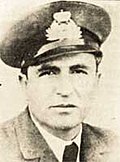Panhellenic Union of Fighting Youths
| Panhellenic Union of Fighting Youths Πανελλήνιος Ένωσις Αγωνιζόμενων Νέων Panellínios Énosis Agonizómenon Néon | |
|---|---|
The Panhellenic Union of Fighting Youths (
, and although it never expanded to become a wider movement, it was one of the most active of the multitude of urban resistance groups that sprung up during the Occupation, and one of the first to carry out active resistance, in the form of bombings.History
Foundation and political aims

The organization was founded in October 1941 by a
Politically, PEAN, like most other similar groups formed in that period, was leftist-socialist, advocating "social justice" and state takeover of crucial sectors of the industry, while being vehemently opposed to any return of the monarchy in the person of King George II. What set it apart from the majority of them, however, was its insistence on active struggle against the occupying forces. Nevertheless, from the outset, PEAN was engaged in a war of words with both the royalist right and the Communist Party-controlled National Liberation Front (EAM), which at the time rejected PEAN's calls for sabotage acts and condemned them as "urban terrorism", a bitter feud that would continue throughout the Occupation.[3]
The ESPO bombing and aftermath

PEAN published a number of newspapers, most important of which was Doxa (Δόξα, "Glory"), first published in April 1942,
The Germans initially blamed EAM for the act, but after the betrayal of the group by
Later history

In September 1943, PEAN, the Athenian wing of
Notes
- ^ a b c Eleftherotypia, 8.4.2006
- ^ Fleischer, pp. 15-16.
- ^ Fleischer, p. 16.
- ^ Most Greek accounts give the casualties as 43 German and 29 ESPO members dead, but these numbers are grossly inflated. Fleischer, p. 17.
- ^ "Death certificate" (PDF). Documentation Centre of Austrian Resistance. February 1943. Retrieved 3 May 2019.
- ^ Fleischer, p. 17.
- ^ Kousouris, p. 66.
- ^ Fleischer, pp. 16-17.
Sources
- Hagen Fleischer (1995). Crown and Swastika - Greece of the Occupation and the Resistance, Vol. 2 (in Greek). Athens: Papazissis Ed. ISBN 960-02-1079-9.
- Kousouris, Dimitris (2015). Δίκες τών Δοσίλογων 1944-1949 [Trials of Collaborationists 1944-1949] (in Greek). Athens: Polis. ISBN 9789604354610.
- (in Greek) "Οι αντιστασιακές οργανώσεις φύτρωναν σαν μανιτάρια" article in the Eleftherotypia newspaper, 8.4.2006
- (in Greek) The bombing of the ESPO building from sansimera.gr
- (in Greek) The ESPO bombing from e-grammes.gr
